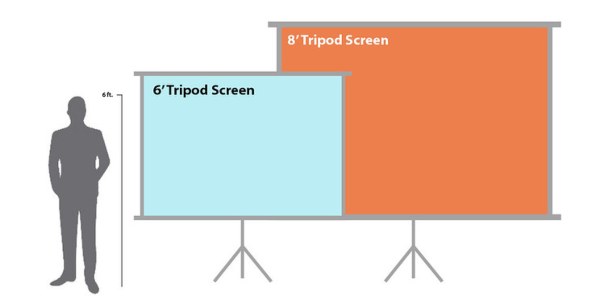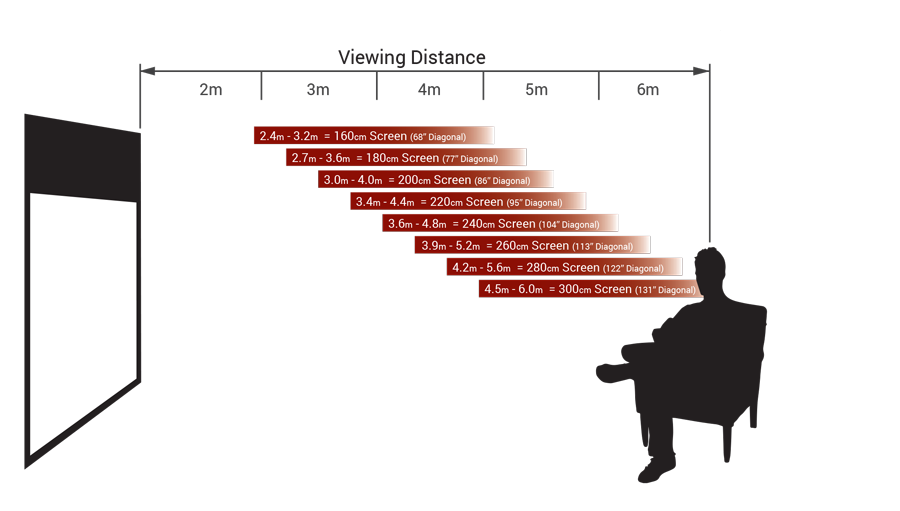To determine the right projector screen size, consider your viewing distance and room dimensions. Choosing the correct size for your projector screen is crucial for achieving the best viewing experience in your home theater or office space.
Factors such as the projector’s resolution, aspect ratio, and throw distance also play a key role in determining the ideal screen size. By understanding these considerations and measuring your viewing distance, you can select a projector screen that enhances visual clarity and overall enjoyment of your multimedia content.
In this guide, we will delve into the essential factors to consider when determining the right size for your projector screen to help you make an informed decision that suits your specific needs.
Factors To Consider
When it comes to choosing the right size projector screen, several factors should be considered to ensure an optimal viewing experience. The room size, screen distance, and screen resolution play pivotal roles in determining the appropriate size for your projector screen. Let’s delve into these factors to help you make an informed decision.
Room Size
Before investing in a projector screen, it’s crucial to assess the dimensions of the room where the projector will be installed. Take into account the height, width, and depth of the space, allowing sufficient room for seating and ensuring that the screen fits comfortably within the viewing area.
Screen Distance
Consider the distance between the projector and the screen, as it directly impacts the ideal screen size. Calculating the throw distance will help determine the suitable dimensions for the projection surface, ensuring a clear and distortion-free image.
Screen Resolution
The screen resolution is another essential factor to consider when determining the appropriate size of the projector screen. A higher resolution allows for larger screen sizes without compromising image quality. Matching the screen resolution to the projector’s native resolution can optimize the viewing experience.

Credit: meetingtomorrow.com
Calculating Screen Size
Understanding the suitable projector screen size for your space is crucial to ensure an optimal viewing experience. Calculating the screen size involves considering the aspect ratio, as well as using specific formulas to determine the height and width of the screen.
Aspect Ratio
Aspect ratio is the ratio of the width to the height of the screen. The common aspect ratios for projector screens are 16:9 for widescreen content and 4:3 for standard content.
Screen Height Formula
To calculate the screen height, you can use the following formula:
| Screen Height (in inches) = Diagonal Screen Size (in inches) Aspect Ratio Height |
Screen Width Formula
For determining the screen width, you can utilize the formula:
| Screen Width (in inches) = Screen Height (in inches) Aspect Ratio Width |
Popular Screen Sizes
Choosing the right size projector screen is crucial for an optimal viewing experience. Below are the popular screen sizes across different categories:
Standard Sizes
- 60 inches: Suitable for small rooms or spaces with limited seating capacity.
- 80 inches: Ideal for medium-sized rooms and offers a good balance between size and viewing comfort.
- 100 inches: A versatile size suitable for most home theaters or conference rooms with average seating capacity.
Large Venue Sizes
- 120 inches: Perfect for larger rooms or auditoriums, providing immersive viewing for audiences sitting farther back.
- 150 inches: Ideal for cinemas, lecture halls, or any large venue requiring a significant screen size for effective visibility.
- 200 inches: Reserved for massive venues like stadiums or outdoor events, offering a grand viewing experience for a crowded audience.
Home Theater Sizes
- 84 inches: Common in compact living rooms or bedrooms for a cozy cinema-like experience.
- 110 inches: Well-suited for dedicated home theaters or spacious living rooms, ensuring a theatrical feel.
- 135 inches: Luxurious size for upscale home theaters or entertainment rooms, catering to enthusiasts seeking a premium viewing experience.

Credit: meetingtomorrow.com
Screen Gain
The screen gain is an important factor to consider when determining the size of the projector screen you need for your home theater or presentation. Screen gain refers to the amount of light reflected by the screen compared to the light received by it. Understanding this aspect will help you choose the right projector screen size for optimal viewing experience.
What Is Screen Gain?
Screen gain measures the reflectivity of a projector screen as light strikes it. A screen with higher gain reflects more light, resulting in a brighter image. Conversely, a lower gain screen reflects less light, which may be suitable for rooms with controlled lighting. The screen gain is expressed as a numerical value, such as 1.0 or 1.5, indicating the amount of light reflected compared to a standard white matte board.
Types Of Screen Gain
- High Gain: Screens with a higher gain of 1.3 or greater are suitable for rooms with ambient light or when a brighter image is desired. However, they may have narrower viewing angles and may be more susceptible to hot spots.
- Standard Gain: Screens with a gain of 1.0 are ideal for rooms with controlled lighting and offer wider viewing angles. They provide a balanced reflection of light for most home entertainment setups.
- Low Gain: Screens with a gain lower than 1.0 are suitable for rooms with low ambient light or dedicated home theaters where light control is crucial. They offer wider viewing angles and minimize color shift for a more uniform image.
Installation Tips
Choosing the right size projector screen is crucial for a flawless installation. By considering the viewing distance and screen resolution, you can determine the ideal screen size that will provide optimal viewing experience for your home theater or conference room setup.
To maximize your projection experience, proper installation is key. Here are some important considerations to keep in mind when setting up your projector screen.Mounting Height
The ideal mounting height of your projector screen will depend on the size of the screen and the layout of your space. Generally, the center of the screen should be at eye level for viewers in the seating area. This ensures a comfortable and immersive viewing experience for everyone.Viewing Angle
Getting the viewing angle right is critical for optimal image quality. Ideally, the projector should be placed at a height that allows the image to hit the center of the screen without any distortion. The angle should be such that viewers can see the entire screen without straining their necks.Screen Material
The choice of screen material can greatly impact the quality of your projected image. Different screen materials have different levels of brightness, contrast, and gain, so it’s important to choose one that suits your needs. For example, a high-gain screen can enhance brightness, but it may result in a narrower viewing angle. On the other hand, a matte white screen offers a wider viewing angle but may not provide as much brightness. When selecting a screen material, consider factors such as the ambient light in the room and the projector’s capabilities. You can also opt for specialized screen materials that offer features like 3D and 4K compatibility for an enhanced viewing experience. Remember, the size and positioning of your projector screen can greatly influence the overall impact of your home theater or presentation. Take the time to find the right mounting height, viewing angle, and screen material, and you’ll be rewarded with a stunning visual experience that surpasses your expectations.
Credit: www.puretheatre.com
Frequently Asked Questions On What Size Projector Screen Do I Need
What Factors Should I Consider When Choosing A Projector Screen Size?
When choosing a projector screen size, consider the room size, viewing distance, and resolution of the projector. The screen size should be proportionate to the viewing distance for optimal image quality and immersive experience.
How Do I Determine The Ideal Projector Screen Size For My Room?
To determine the ideal projector screen size, measure the distance between the screen and the seating area. Multiply this distance by 0. 84 to get the recommended screen width. For example, if the distance is 10 feet, the optimal screen width would be 8.
4 feet.
What Is The Aspect Ratio And Why Is It Important For Projector Screens?
The aspect ratio refers to the proportional relationship between the width and height of the screen. It is important to consider the aspect ratio of the projector when choosing a screen, as mismatched ratios can result in distortion or black bars on the image.
Is It Necessary To Have A Larger Screen For A High-resolution Projector?
For a high-resolution projector, a larger screen is not necessarily required. The resolution determines the level of detail in the image, while the screen size determines the viewing experience. It’s important to find the right balance between resolution and screen size for optimum clarity and enjoyment.
Conclusion
Choosing the right projector screen size is crucial for an optimal viewing experience. Consider the room dimensions and seating arrangements to determine the ideal screen size. Remember, the size of your projector screen can significantly impact the quality of your visual presentations or movie nights at home.
Follow these tips and make the right decision for your space.


0 comments